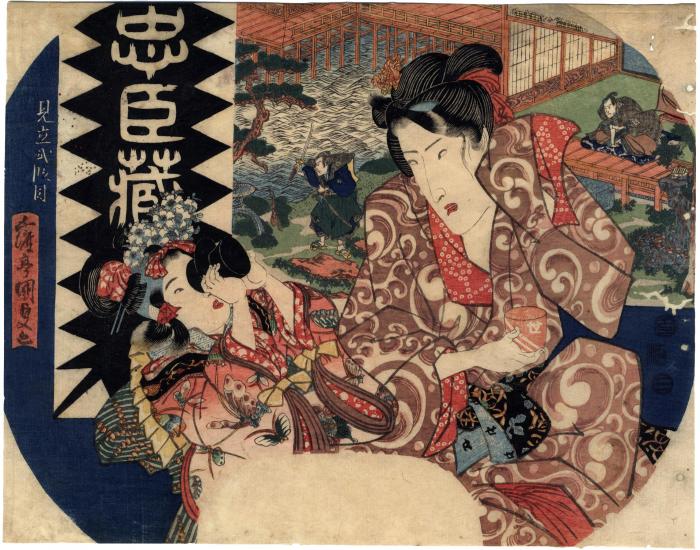Utagawa Kunisada (歌川国貞) / Toyokuni III (三代豊国) (artist 1786 – 01/12/1865)
Fan print of a courtesan with her child assistant - the background is the Matsu kiri scene from Act 2 of the Chūshingura with Kakogawa Honzō lopping off a pine branch - a mitate (見立)
1829
11.5 in x 8.75 in (Overall dimensions) Japanese woodblock print
Signed: Gototei Kunisada ga
五渡亭国貞画
Publisher: Ibaya Senzaburō
(Marks 127 - seal 08-067)
Date seal: 1829
Censor's seal: kiwame
British Museum - Hokusai version of background scene
Lyon Collection - Natori Shunsen portrait of Kakogawa Honzō "In the play [the Chūshingura] Kakogawa Honzo [加古川本蔵] appears to support his master Momonoi Wakasanosuke's resolve to exact revenge on Moronao by violently slashing the branch off a nearby pine with Wakasanosuke's sword."
"...Honzō cuts off a pine branch with his master's sword, which he then puts back in its sheath without cleaning it. By doing so, he hopes to make the sword stick in the scabbard from the resin, and thus prevent Wakasanosuke from drawing his sword too quickly and committing a serious crime."
Quoted from: 'Mitate kokkei Chūshingura. Hiroshige's humorous parodies of the Loyal Retainers' by Pierre Wijermans and Henk Herwig, Andon 84, November 2008, fn. 18, p. 72.
****
Note the use of Prussian blue, a newly imported and very expensive pigment. This color had only recently first appeared on Japanese woodblock prints and says something about the publisher's confidence in the market and the connoisseurship of their buyers. This fan print must have been an extremely exciting sheet when it was originally offered to the public. Most likely the publisher asked a higher price for this item, if only to better recover their costs.
****
Use the enlarging tool and look closely at the figure in the background and you will see that he has just cut the limb from the tree and it hasn't even hit the ground yet.
In the foreground the child has a robe decorated with butterflies, often a symbol of souls which have passed on to the afterlife. The woman is holding a cup with a character on it and which is repeated on the fabric of her obi. There are three diagonal lines running across the side of the cup. Are these line of the Danjūrō's crest, the mimasu or three nested measures of rice? A sly tribute and reference?
****
The dentate pattern on this print is a give away that it is a Chūshingura-themed prints. But not all prints devoted to this story show these designs. "The distinctive dentate pattern on the coats is an iconographical motif which represents the inescapable progress of day and night, symbolizing unfailing loyalty."
Quoted from: 'Mitate kokkei Chūshingura. Hiroshige's humorous parodies of the Loyal Retainers' by Pierre Wijermans and Henk Herwig, fn. 32, p. 73.
Ibaya Senzaburō (伊場屋仙三郎) (publisher)
Chūshingura (忠臣蔵 - 47 Rōnin) (genre)
mitate-e (見立て絵) (genre)
beautiful woman picture (bijin-ga - 美人画) (genre)
